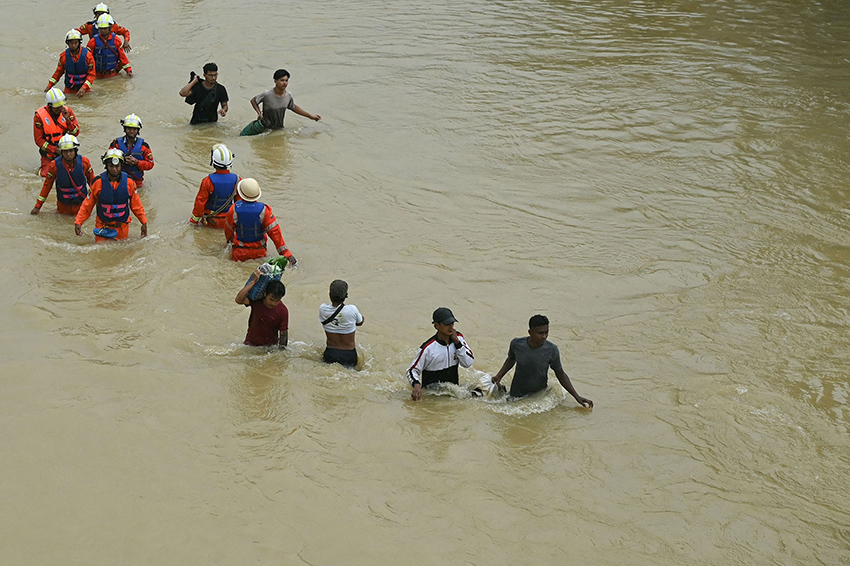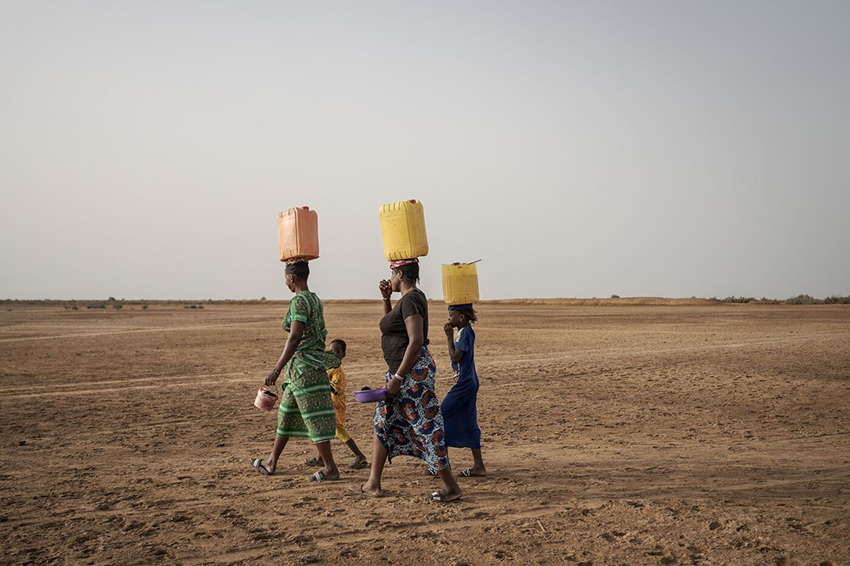|

By
Aaron Rutkoff
November 15,
2023
Water Consumption is now a big deal.... A climate-driven water grab
Water is now a global asset, and a growing threat
To measure all the ways humans move our dearest
commodity around the planet, researchers devised two categories of
water. Physical water pools in reservoirs and comes out of the faucet.
It’s wet. Virtual water, on the other hand, is the invisible history
of all the H2O used to make stuff: tomatoes, solar panels, wood and
almost everything else. Not necessarily wet.
Global average temperatures spiked by 1.8C in September; it was a
shock to scientists. The atmosphere sponges up 7% more water vapor
for every additional degree Celsius. That’s a kind of virtual water,
in a way — impossible to see and easy to forget. Except when it
becomes a very physical flood raging through the streets.

Featured in Bloomberg
Green, Issue
Nine, Fall/Winter 2023 Cover
Illustration: Philotheus Nisch
As a matter of economics, water is mostly virtual. The physical
liquid is
only 0.0002% of the global trade. That means the real economics of
water is mostly hidden, just like the climate consequences. Until
they’re not.
The drinking
water for people in greater Dakar can
be far more lucrative in
virtual form as alfalfa.
Feed it to livestock far from West Africa, and it can be turned it
into beef — and profits for investors. China’s richest person doesn’t
sell software or electric vehicles; he runs a bottled water empire
that’s been busy privatizing
a shared natural resource.
Banks, pension funds and insurers.

In this warming world, controlling water matters in new ways. It’s
both a threat and an asset.
Welcome to the
ninth issue of Bloomberg
Green’s
magazine.
Stories from the latest issue have been rolling out for the past few
weeks, and everything we’ve published is now available on this
collection page. The only magazine focused on climate and the
energy transition is sent to our all-access subscribers, so sign
up today to receive a print edition along with full digital access
to Bloomberg
Green. Here
are some of the highlights so far…

Residents walk through a flooded
street in Myanmar's Bago region on Oct. 10. Photographer:
Sai Aung Main/Getty Images

A drone photograph of excavation
sites in Jamestown, Virginia, Aug. 31, 2023. Photographer:
Shaban Athuman for Bloomberg Green
-
The US and China are inching closer on climate. Progress
at the global COP28 gathering in Dubai will depend
greatly on the world’s two biggest emitters and the veteran
negotiators representing them.
-
The bankers are back for COP28. Big-name
finance chiefs are
expected to turn out in force for the next UN climate summit.
-
A startup is battling Big Oil for the $1 trillion future of carbon
cleanup. Climeworks
is a pioneer in carbon-capture technology. Can it grow
quickly enough to make an impact in the climate fight?
-
To meet climate goals, Gulf countries will have to overhaul
everything. When
Dubai hosts the COP28 climate conference, the tension between Gulf
countries’ net-zero targets and reliance on fossil fuels will
be front and center.

Gulf countries have some of the cheapest oil
production in the world and some of the cheapest gasoline
domestically. Photographer: Natalie
Naccache/Bloomberg

Illustration: EunJeong Yoo

A view of Freshkills Park in Staten
Island, N.Y., on October 4, 2023. Photographer:
Bryan Anselm for Bloomberg Green
Road to COP
By John
Ainger and Jennifer
A. Dlouhy
The COP28 climate summit in Dubai later this month is perhaps the last
chance for the world to change course and start cutting emissions this
decade. After months of bumps and hiccups, things may be clicking into
place for the meeting to make progress.
The US and China, the world’s biggest polluters, vowed to step up
joint action to tackle climate change in a revival of collaboration
that will be crucial
for a successful COP. The bilateral deal between Washington and
Beijing comes after negotiators secured a framework deal to set up a
fund to help vulnerable nations deal with loss and damage from
increasingly extreme weather — something
that just two weeks ago looked as though it could upend the talks.

COP begins on Nov. 30. Photographer:
Waleed Zein/Getty Images
It adds up to momentum for the United Nations conference in two weeks
time, which will focus on charting how far off course the world is to
keeping global warming below 1.5C and what needs to be done to correct
it. Key barometers for a good outcome include clear commitments on
phasing out fossil fuels, while also providing funding for those
countries dealing with the most severe impacts of climate change.
Continue
reading this
story and find out more about what to expect at COP28 on
Bloomberg.com.
In the past two decades, large food and investment companies have
acquired more than 12 million hectares of African farmland. The
land-buying spree, stoked by rising demand for food among the world’s
growing middle class, has spurred a run on an even more precious
resource: water.
One example where this is taking place is in Senegal, where an
investment company is using the country’s only lake to irrigate crops
it plans to send to Saudi Arabia. All the while, the taps in coastal
Dakar barely trickle. Read
more in today’s
Big Take on Bloomberg.com.

Villagers carry water back to their homes in Lugdemiss Tableau in
northern Senegal. Photographer:
Annika Hammerschlag/Bloomberg
The US plans to push for more
nuclear power at COP28.
A group of countries led by the US will pledge to triple the amount of
installed nuclear power capacity globally by 2050, marking a major
turnaround for the controversial technology at the climate
negotiations.
JPMorgan has a new way to gauge
green progress. The
biggest US bank says it’s including zero-carbon power generation in
how it measures emissions tied to its lending to oil and gas
companies. It’s also calling for more action
on methane leaks in the sector.
Trees can
only do so much. Protecting
and restoring forests could help store billions of tons of carbon
dioxide, according to a new study. But it’s not a failsafe strategy.
Weather Watch
By Brian
K Sullivan
There is even a 10% chance it develops into a
tropical system later, the US National Hurricane Center said. More
likely conditions won’t be right for that to happen but the storm will
track up the East Coast and bring rain to Maine and the Canadian
Maritimes on Saturday.
In addition to the flood threat from the rain, a high-surf advisory
has been raised for Florida's southeast coast, including Miami, where
waves could reach up to 10 feet and dangerous rip currents are
likely.

A satellite image showing a
weather front over Florida on Nov. 15. Source:
NOAA
In other weather news:
Caribbean: In addition to the system sweeping Florida, another one in
the western Caribbean has a 30% chance of spinning up into 2023’s next
Atlantic storm in 48 hours, the hurricane center said. Regardless of
whether it forms, it will likely bring heavy rain across the region,
including Haiti, which is prone to mudslides and flooding.
Pacific: In the South Pacific Tropical Cyclone Mal has passed by Fiji
and will now weaken as it moves away from land. Elsewhere, global
forecasters are watch two systems in the western Pacific to see if
they will become tropical, as well as another in the Bay of Bengal in
the Indian Ocean.
UK: Another Atlantic storm will roll in on Thursday bringing clouds
and rain to the southern UK. “As we go through Thursday morning itself
then, a wet and windy story across many southern areas,” said Alex
Burkill, a UK Met Office meteorologist in a briefing. As much as three
to four centimeters of rain could fall together with gale-force winds,
he said.
Green Play Ammonia™, Yielder® NFuel Energy.
Spokane, Washington. 99212
509 995 1879 Cell, Pacific Time Zone.
General office: 509-254 6854
4501 East Trent Ave.
Spokane, WA 99212
|